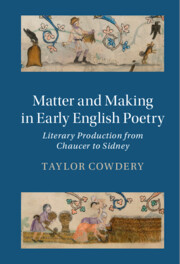Book contents
- Matter and Making in Early English Poetry
- Cambridge Studies in Medieval Literature
- Matter and Making in Early English Poetry
- Copyright page
- Contents
- Acknowledgments
- Abbreviations and Editorial Conventions
- Introduction
- Chapter 1 Words and Deeds in Chaucer
- Chapter 2 Gower and the Crying Voice
- Chapter 3 Hoccleve and the Force of Literature
- Chapter 4 Lydgate and the Surplus of History
- Chapter 5 Copy and Copia in Skelton
- Chapter 6 Wyatt’s Grace
- Epilogue
- Notes
- Bibliography
- Index
- Cambridge Studies in Medieval Literature
Introduction
Published online by Cambridge University Press: 15 June 2023
- Matter and Making in Early English Poetry
- Cambridge Studies in Medieval Literature
- Matter and Making in Early English Poetry
- Copyright page
- Contents
- Acknowledgments
- Abbreviations and Editorial Conventions
- Introduction
- Chapter 1 Words and Deeds in Chaucer
- Chapter 2 Gower and the Crying Voice
- Chapter 3 Hoccleve and the Force of Literature
- Chapter 4 Lydgate and the Surplus of History
- Chapter 5 Copy and Copia in Skelton
- Chapter 6 Wyatt’s Grace
- Epilogue
- Notes
- Bibliography
- Index
- Cambridge Studies in Medieval Literature
Summary
The introduction defines the two key terms of the book, “matter” and “making.” For the early English court poets, “matter” was a relative term. In its most concrete sense, it denoted the pre-existing textual sources that a poet used as the basis for his poetry, but it also referred, in a broader and Aristotelian sense, to whatever materials a poem was understood to be made from. “Making referred to the set of techniques that early writers used to rework matter into poetry, and it had its origins in classical rhetoric: a poet was said to begin by “inventing” (or identifying) matter on which to work, and only afterwards to “dispose” (or restructure) that matter into a new form and shape. “Making” differs from the Scholastic model of authorship, which stresses the authority (or auctoritas) of the writer, and it also differs from early modern theories of authorship, which stress the autonomy of the literary work. It persists as the prevailing method for writing poetry even to the reign of Elizabeth I, although literary attitudes towards matter in particular begin to shift during the sixteenth century.
- Type
- Chapter
- Information
- Matter and Making in Early English PoetryLiterary Production from Chaucer to Sidney, pp. 1 - 14Publisher: Cambridge University PressPrint publication year: 2023

